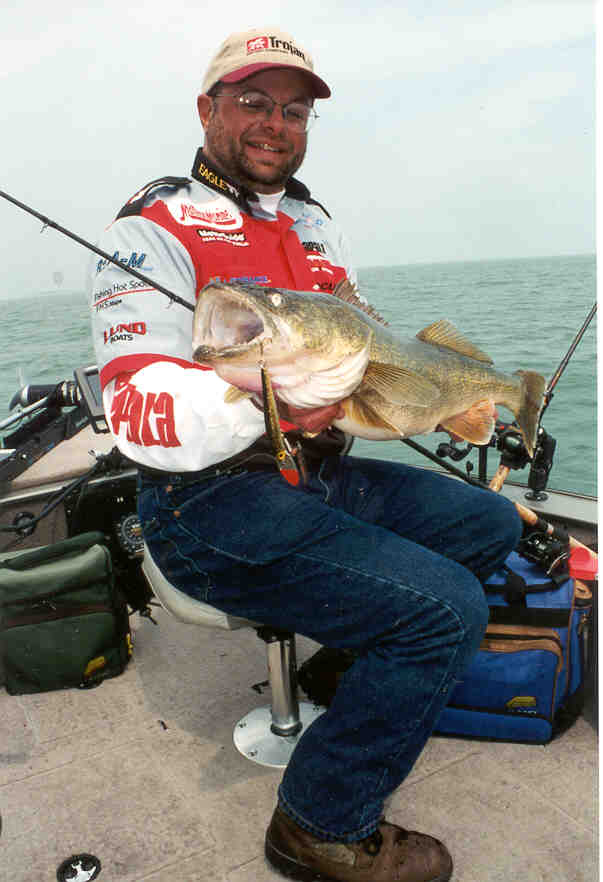The Complete Fishing Scene on Lake Erie
Subscriptions |
Fishing Reports &
Message Boards |
Charters | Lodging |
Walleye.com Shop
Guest Book What's New Contact Us Current Lake Conditions Boats For Sale
|
The Complete Fishing Scene on Lake Erie |
|
Guest Book What's New Contact Us Current Lake Conditions Boats For Sale |
Lake Erie Walleye Magazine
Summer 2002 Vol. 8, No. 2
Feature Article
|
HOT OFF THE PRESS
|
Walleye Night Moves by Mark Martin
E very evening, when light gives way to night, wall eyes make movements like clockwork, shifting their position from deep to shallow, with a spell spent in between. They start out over and around structure, slip onto the edges, then slide atop the flats. That¹s why, when the fish are in motion with nothing more than short stopovers, you had better be, too.
short stopovers, you had better be, too.
Knowing how to pattern the fish and their nocturnal progressions, along with the timing of their movements, will keep you on walleyes when other anglers are sitting on spots that shut down hours ago. But more than your location must change. You need to follow the fish from different levels in the water column with offerings that are better suited to low light and are most appropriate for the shallows and their edges. Add to the mix the right gear and boat rigging, and you¹ll be prepared to stay with the walleyes long after dark. Night Moves Starting in evening, everyone's most popular fishing time, walleyes will still be in daytime mode. They’ll be on or adjacent to main-lake structure such as underwater islands and reefs close to deep water. Sometimes the fish will be right on the bottom at 10, 12 or 15 feet, but other times they'll suspend nearby at the same depths over 50 to 80 feet of water. The most effective way to locate them is by pulling a spinner and night
crawler behind a Northland Rock-Runner bottom bouncer. For the blades, check
out Northland's holographic models, which I've found produce better than
painted blades under almost all conditions. If the water's clear and lacks
obstructions, you can get
As soon as twilight arrives, be ready to abandon the earlier areas. Now I begin to search shoreline-adjoining structure near deep water. Try points, reefs, drop-offs and weed beds. The fish won't show up all at once, but they'll begin showing up gradually. More of them will be there as it gets darker and darker. At this time, I focus on eight to 15 feet of water‹staging areas before the walleyes move shallow. It seems as if the walleyes are getting their bearings. You can often see the fish on a locator, but you won¹t want to run over them with the gas outboard and go back to fish them in the shallow water. They'll be gone. But you can scout them out and return later. Here I go after them primarily with crankbaits. Crawler harnesses still work and can often be excellent, but too often I have to fight off other kinds of fish, including sheepshead and bullheads. (Harnesses can keep up with cranks but seldom outproduce them.) That¹s why I prefer the cranks on spinning tackle with 6- or 8-pound FireLine. My favorites are Rapala Husky Jerks in both the shallow and deep-diving versions. To them I add a piece of WTP tape for added visibility. I also paint a thin strip with glow paint around the head and tail to help the walleyes zero in on the bait. Quite often I add scent as well, something like Berkley walleye scent. To work them, I cast out, crank the lures down, stop, sweep the bait, stop and repeat. That’s about all there is to it. At times you’ll want to vary the length of the pauses, letting the bait rest for 10, 15, even 30 seconds. Experiment till you find what the fish want. Know that a strike will often be nothing but a "tick." If you feel it, be sure to set the hook. Beyond twilight, walleyes will move shallower yet, into three to six feet of water. The most productive all-around depth range, though, is five to 10 feet. The same areas apply; just move shallower. Again I like to cast Husky Jerks but will often switch to trolling to cover water. To move the bait slowly, I put my Motor Guide 107-pound-thrust trolling motor on low speed, just fast enough to make the bait wobble. But here I switch to a No. 13 Original Rapala with a split shot for weight ahead of it. Again, a strike won't be more than a "tick." For that reason, I like to troll the Rapalas on 20-pound FireLine for its lack of stretch and extreme sensitivity. A solid baitcasting rod like the 7-foot, 10-inch Berkley Lightning Rod allows you to pick up line and better set hooks. Now that you have the right stuff and the knowledge of the walleye’s whereabouts, you'll be ready to find fish with confidence and comfort. When you’re out there, looking for fish during the evening-to-night transition, don’t let the fish come to you, keep searching so you can keep up with the fish’s movements.
|
|
|
|
|
WE DELIVER! |